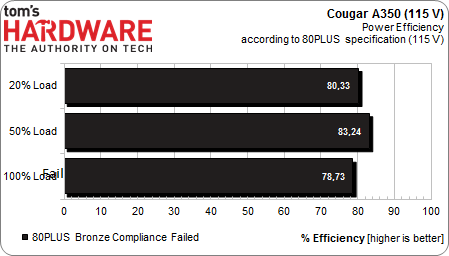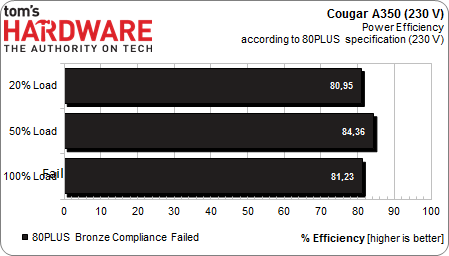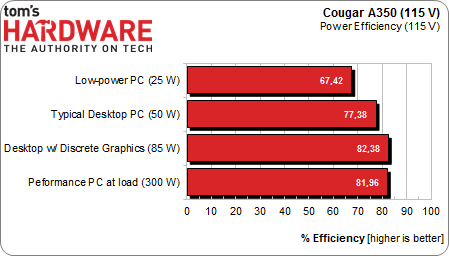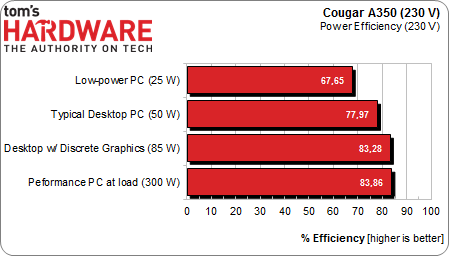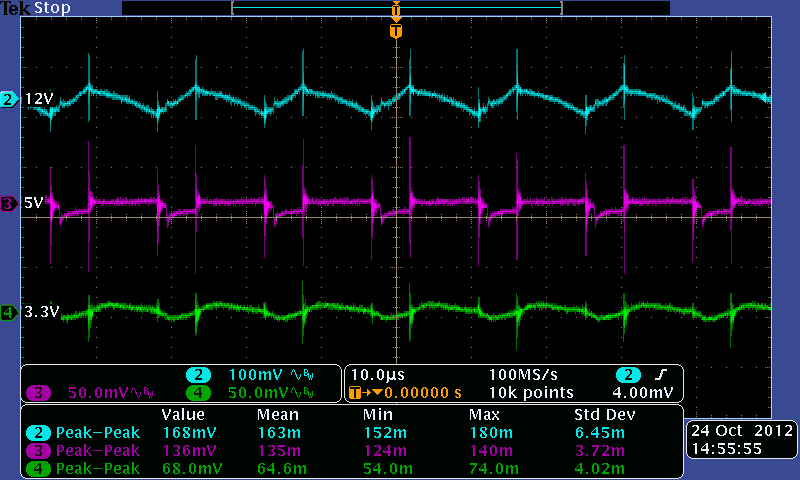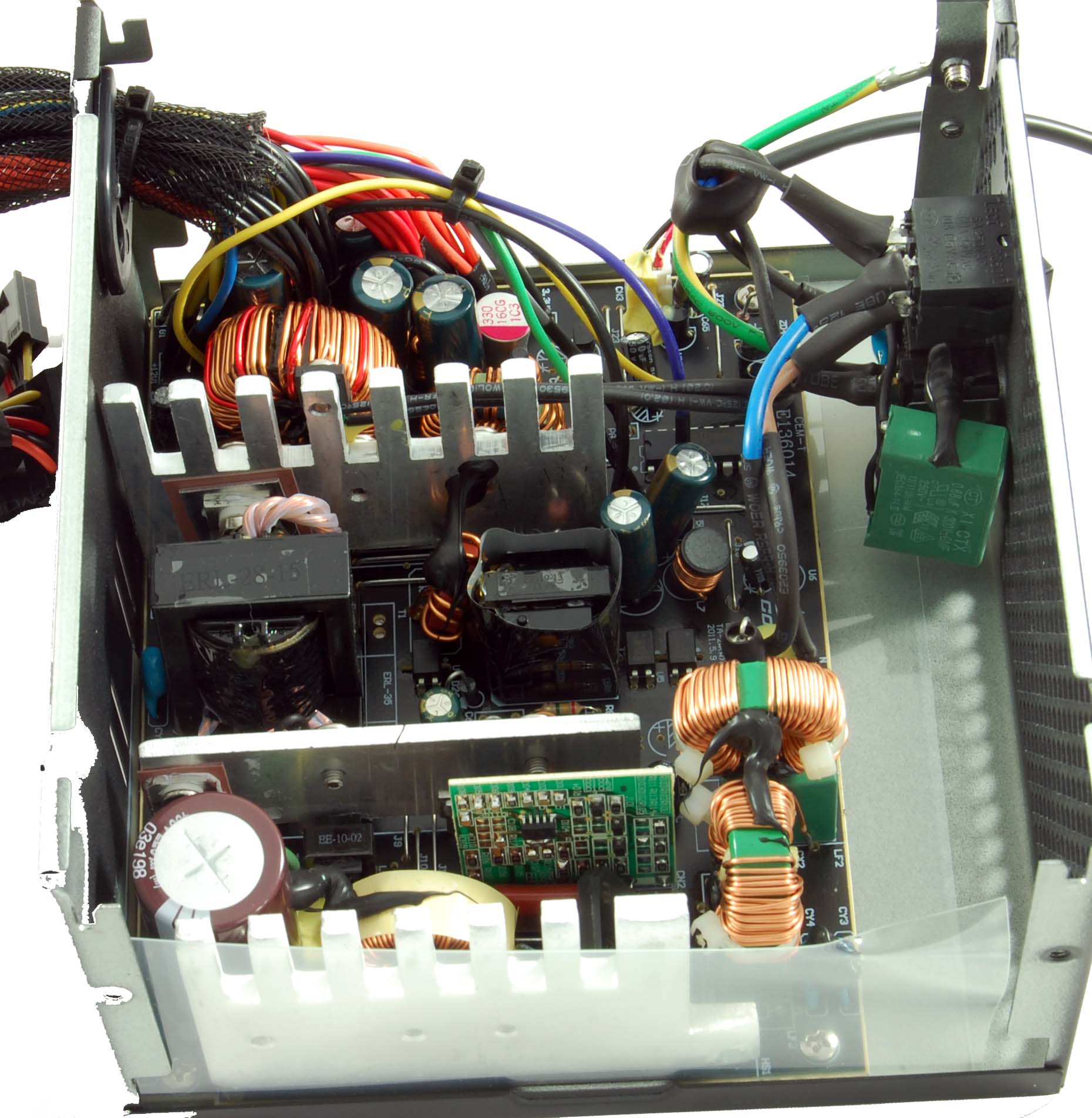Part 1: Four Cheap 80 PLUS Bronze Power Supplies, Reviewed
Power supply manufacturers condition us to think that efficiency is the one variable you need to pay the most attention to. But we have a suite of tests that more thoroughly taxes PSUs. Can these four inexpensive units under $70 make it through unscathed?
Cougar A350: Measurements
Efficiency According to the 80 PLUS Spec
Efficiency by Load
Cougar's A350 does not pass all of the tests in our suite. While the ripple and noise metrics come back fine, we discovered that the voltages on the 3.3 V and the 5 V rails are marginal at 100% load. They're not in violation of the ATX spec, but they're close. In other words, there are no reserves at all. Exceed the specified amps just a tad, and you get out-of-spec voltages.
But that’s not even the main flaw. The real problem is that this power supply fails to satisfy its 80 PLUS Bronze rating, coming up short in the efficiency requirements in all three load ranges. In one case, the 20% load test, it's more than three percent shy of the specification. Such a clear shortcoming cannot be excused as a measurement variance. As a result, any other positive test result becomes irrelevant; the A350 fails.
A Close Look at the PCB
When we look inside of Cougar's submission, we see a couple of likely causes for the failure. We definitely get the impression that cost-cutting was one of this product's design criteria. Instead of shrink tubing, we find globs of insulating paste. At least the soldering job seems alright. The capacitors on the secondary side are manufactured by Taiwan-based Teapo. The big capacitor on the primary side is sourced from United Chemi-Con. The input filter, spread across a sub-PCB next to the mains socket and the main PCB, looks somewhat haphazard. The visual impression of this PSU reinforces our negative test results.
Get Tom's Hardware's best news and in-depth reviews, straight to your inbox.
-
InvalidError Reply
Some Chinese OEMs put rocks, small concrete blocks, lumps of steel or other stuff like that disguised as a transformer with bits of wire that aren't connected to anything to trick people into believing their heavier PSUs are better.11435905 said:always judge a power supply by its weight.
So weight alone is not a reliable indicator.
Also, at high frequencies and high efficiencies, the size of inductors, capacitors, transformers and heatsinks along with the associated weight shrink. While light weight and high quality may rarely be seen together, they certainly are not mutually exclusive. -
dudewitbow Reply11435841 said:no love for the EVGA 500B?
a good chunk of Tom's physical hardware reviews generally are conducted in europe. This goes for a good handful of the gpu tests as well. EVGA rarely ever shows up on review sites because of it(and possibly due to lack of EVGA response to a hardware review pitch)
-
computer_nugget2 Reply11435944 said:
Some Chinese OEMs put rocks, small concrete blocks, lumps of steel or other stuff like that disguised as a transformer with bits of wire that aren't connected to anything to trick people into believing their heavier PSUs are better.11435905 said:always judge a power supply by its weight.
So weight alone is not a reliable indicator.
Also, at high frequencies and high efficiencies, the size of inductors, capacitors, transformers and heatsinks along with the associated weight shrink. While light weight and high quality may rarely be seen together, they certainly are not mutually exclusive.
do you have pics to prove this?
-
envy14tpe This is PART 1. Which means more PSUs to come, so let's hope for no dumb comments asking why not this PSU or this one...Reply -
jimmysmitty Reply11436142 said:This is PART 1. Which means more PSUs to come, so let's hope for no dumb comments asking why not this PSU or this one...
They have already listed the PSUs for part 2 and I didn't see a part 3 listed. I wonder where the Corsair CX430 is. Its a 85+ Bronze PSU and is $39.99 on Egg right now. Its one of the best entry level PSUs I have actually used as well and compared to other PSUs at the same price point or higher (within 550W and may or may not be 80+ at all) I have seen less of them come back bad. -
razor512 Reply11435905 said:always judge a power supply by its weight.
While weight is an important factor, overall weight is 100% useless
for example check out the SIGMA SHARK SP-635
http://www.ocia.net/reviews/sigma635/page2.shtml
it is probably one of the heaviest power supplies you will find (with the exception of some of the 1200 watt ones)
I purchased it a while back and was disappointed at the internals. they used an insanely thick case that made the power supply weigh a lot but the insides were were the result of the owner of the company asking while walking around china, what are the cheapest items we can find on the shenzhen market today.
(at least the power supply can double as a flail or a boat anchor) -
pyro226 Hoping to see the CX430 and other corsairs reviewed. I like the little thing since it powers my PC. :D It originally rang a bit when the computer was suspended or at random after a few hours of use, but that went away with age.Reply
